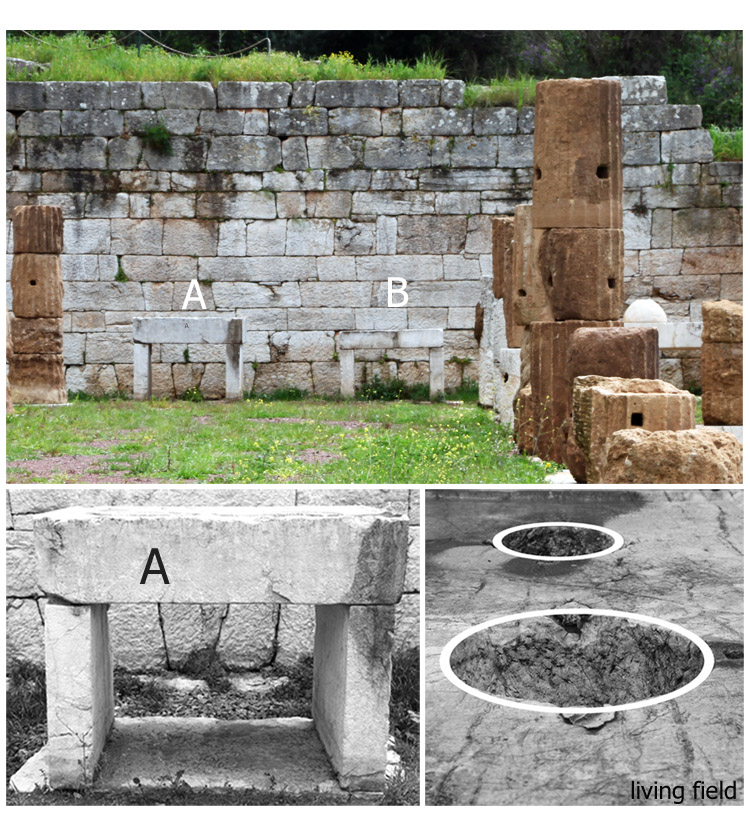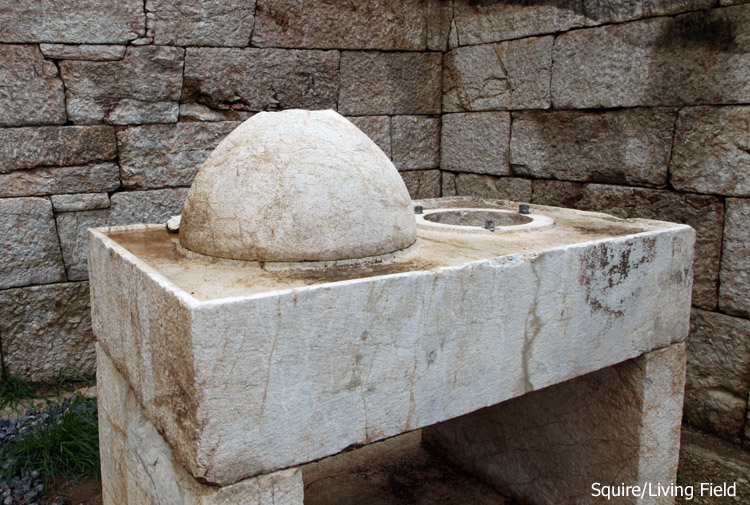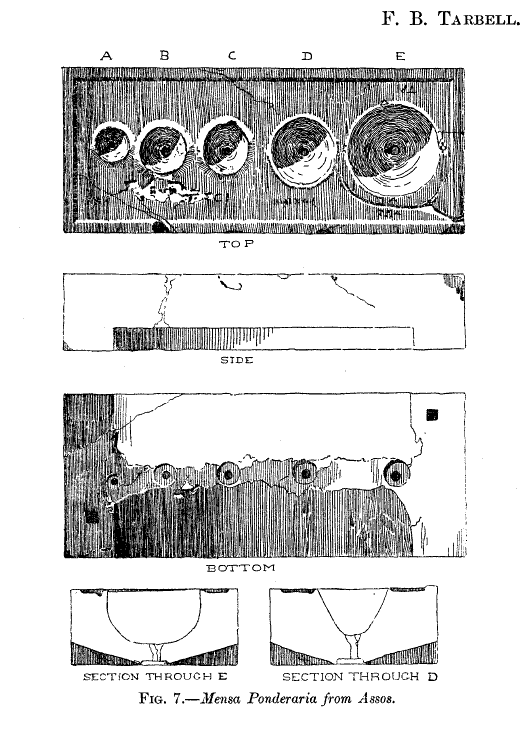Standard measures for checking the dry volume of produce such as grain and fruit have been in place since trade in agricultural products began. A barrel or basket holding one bushel (8 gallon or 36.4 litre) was once commonly used in Britain. (See Light on bushel.) The following is an example of a device used in Ancient Greece and Rome.
The measuring tables at Ancient Messene
At the archaeological site of Ancient Messene in the Peloponnese, Greece, there are stone tables into which hemispheres or bowls have been carved. A notice nearby states that these measuring standards were found during the excavation in what was originally part of a communal space (the agora). The bowls were “for testing the capacity of the containers used by merchants who were selling dry fruits and grain”. Images of the tables and bowls are shown below.

The tables are sited by a wall under the letters A and B in the upper image. Table A is shown lower left; it measures more than 1 metre in length. Each table has two bowls carved into it, identified by the white ovals, lower right.
The bowls have a rough surface, and holes at the bottom which would have been fitted with stoppers. The holes were large enough for grain to pour through when the stoppers were pulled out.
There was one further table, positioned in a corner made by two walls. One of the bowls seemed to have a hollow stone hemisphere placed on top of it (image below), the purpose of which is unclear.

The ‘mensa ponderaria’ at Assos (after Tarbell)
This type of table, known generally as a ‘mensa ponderaria’ was widespread in the ancient world. F. B Tarbell gives an account of one found at Assos, an ancient site in Turkey. The table from Assos is a block of marble – 1.11 m long , 0.455 m broad and 0.21 high – in which have been excavated 5 bowls of differing volume. For various reasons, including that the surfaces of the five bowls are rough (as at Messene), it is believed they were originally lined with bronze. There is a copy of a drawing from Tarbell’s article below. A photograph of this mensa can be seen online at the Boston Museum of Fine Arts (see references). The bowls are estimated to have held between 0.27 and 4.62 litre.

The largest bowl from Assos is therefore about 13% of a bushel. These capacities look at though they were designed for ground material or fine seed, for example ground spices or meal or cleaned seed of small-seeded crops. Coarser material such as fruit and husked grain contains a lot of air space that can cause packing errors when poured into such small containers.
Concluding
The stone tables and bowls at Messene appeared larger than the ones from Assos (but unfortunately they were not measured during the visit). From memory, the largest bowl would hold about half a bucket or one-third of a bushel, which is getting a bit closer to the practical size for measuring the dry volume of rough grain that retains husks, such as oat and barley, or small-sized fruit.
Ancient Messene was founded 369 BC, around 2400 years ago. These durable measuring tables indicate the importance of standard weights and measures to an advanced society that depended on agriculture, and on trade in produce, and wanted to be, and seen to be, fair and to avoid having the people misled by traders and merchants.
Sources and references
Tarbell FB. 1891. A “Mensa Ponderaria” from Assos. The American Journal of Archaeology and the History of the Fine Arts 7, 440-44. Online at:
http://www.jstor.org/stable/496471?seq=2#page_scan_tab_contents
Photographs of the Assos mensa ponderaria at the Boston Museum of Fine Arts: http://www.mfa.org/collections/object/measurement-block-mensa-ponderaria-199469
The archaeological site of Ancient Messene, search at http://www.visitgreece.gr
Author/contact: geoff.squire@hutton.ac.uk or geoff.squire@outlook.com. Photographs taken by the author on a visit to Ancient Messene.
